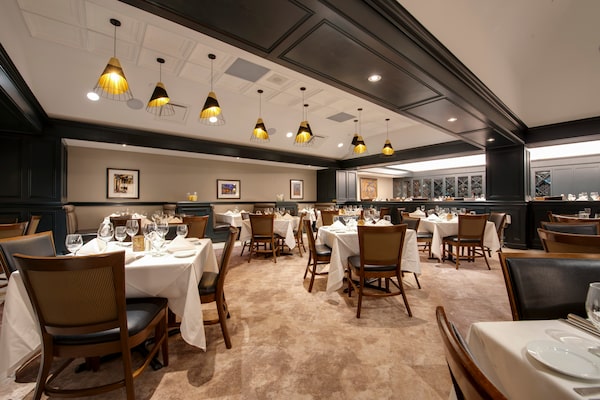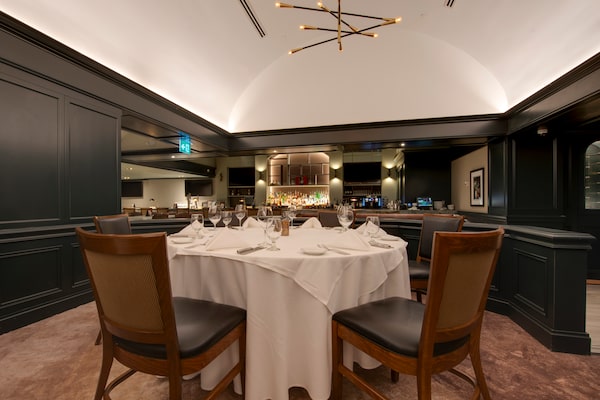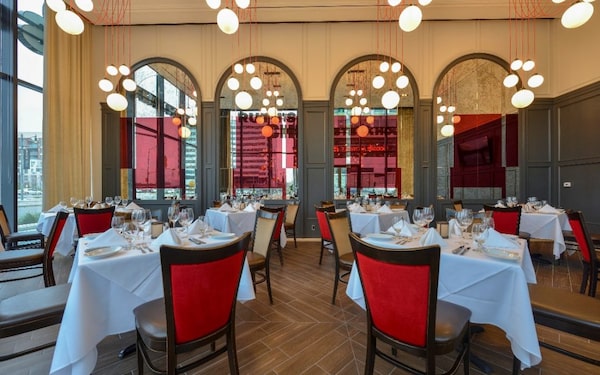
Lana Duke owns three Ontario Ruth's Chris franchises, along with another three in Texas.Stephen Uhraney
There are few restaurant concepts as steeped in tradition as a steak house. And there are few restaurant experiences as consistent as a visit to a Ruth’s Chris Steak House.
So when it came time to renovate Ruth’s Chris’s 25-year-old flagship Canadian restaurant in downtown Toronto, there were many regular diners who said they didn’t want to see anything change.
It’s been likened to a speakeasy, because you have to seek out the wood-panelled restaurant that’s tucked away at the end of a corridor in a lower level of the Hilton Hotel at Richmond Street West and University Avenue. But after more than two decades of service, it was high time to refresh and expand the restaurant’s features. The idea was to reconceptualize the storied restaurant to suit a new generation, says Lana Duke, the franchise owner of three Ontario locations and another three locations in Texas.
You have to seek out the Ruth's Chris on the lower convenion level of the Hilton in downtown Toronto.Wallace Immen/The Globe and Mail
Ms. Duke was part of the original team who worked with company founder Ruth Fertel. Ms. Duke has watched as the Ruth’s Chris brand expanded to 155 locations worldwide. Over those years, the Canadian clientele shifted from primarily businessmen and travellers to an equal mix of men and women, many of whom live locally.
Distinctive decor with a consistent menu
While the menus are consistent in every Ruth’s Chris, each restaurant has a distinctive decor. Steak houses traditionally have features such as banquettes, a lot of wood and crown mouldings and subdued lighting. But a new generation of diners wants a lighter more contemporary look, says Ms. Duke’s son, R. David Duke, who served as the project manager for the Toronto renovation, which was completed in mid-November.

The Ruth's Chris downtown Toronto interior, before renovations.Google Photography
During the three-month rebuild, the panelling and trim that originally had a tobacco-brown finish was sanded and repainted in a rich green-black, better suited to new lighting that’s brighter and more focused on the tables, says Matthew Davis, principal and founding partner of the Toronto-based DesignAgency, which created the remodel design that was executed by Gaydon Contractors Ltd. of Richmond Hill.
In the new design, there are only three banquettes, while the heavy club chairs at the tables were replaced with lighter chairs, in an era when the atmosphere is more fluid and social. “Sharing meals is more common today and people want chairs that are comfortable and easy to move,” Mr. Davis says.
New design offers what customers want: more light and flexibility
The renovation also allowed for much more flexibility. Now, the space features three private dining rooms that are separated from the general dining area, bar and lounge by pocket doors. The dining areas can be used separately or as a large group space when dividers are removed. Each room has a TV that can be used for presentations.
The private dining area feels more connected to the restaurant than it did in the past, owing to glazing in the windows that let in light and the removal of a raised floor that was a legacy from the restaurant’s original tenant. (It had been the grill area of a location of the Polynesian-themed Trader Vic’s, which Ruth’s Chris replaced in 1995.)

The restaurant's new look is more open and light.Google Photography
The ceilings, which were originally quite low, were significantly raised, but the detailed crown mouldings and decorative wood trims were retained. Floors in the entry and bar area were finished in a marble-like white ceramic flooring, replacing carpeting. The effect is to retain the intimate steak house look, but make the space feel larger and more open, Mr. Davis says. There is still carpet in the restaurant areas.
A major change is a much more extensive bar. The original bar at the downtown location only seated six; the new bar seats 18, plus their adjoining casual tables with bar stools, reflecting a trend toward more informal dining at the bar.

The tobacco-brown panelling was repainted in a rich green-black, better suited to new lighting that’s brighter and more focused on the tables.Google Photography
“In San Antonio, we put in a 90-seat bar and I thought David was nuts to do it, but it’s full every night,” Ms. Duke says. “They love to sit at the bar; it’s a place where people meet other people,” and particularly popular for watching sports and pre-theatre.
The start of Ruth’s Chris was unusual
In her career that goes to the beginning of Ruth’s Chris, Ms. Duke has learned some valuable lessons. Born in Canada, she became a publicist for the company founded by Ruth Fertel, a single mother of two in New Orleans who bought a restaurant called Chris steak house in 1965.
After a fire, Ms. Fertel moved to a new location, but found she didn’t own the Chris name, so she rebranded the new location as Ruth’s Chris.
The ceilings at the downtown Toronto steak house were significantly raised and new lighting was installed.Wallace Immen/The Globe and Mail
While Ms. Fertel took in partners in 1999, she retained a majority interest in the chain and remained a force in the company until her death three years later.
Now publicly owned, Ruth’s Hospitality Group is based in Winter Park, Fla. and trades on the Nasdaq.
Long career marked by success and failure that prompted more success
Ms. Duke persuaded Ruth to grant her the franchise in Toronto. There’s always been a symbiotic relationship between the steak houses and hotels, she’s found.
Her biggest miscue was launching her second Toronto area location as a stand alone in Mississauga, at the corner of Burnhamthorpe Road West and Hurontario Street near Square One Shopping Centre.
“That was a mistake at the time because the sweet spot for the size of one of our restaurants was 8,000-square-feet,” Ms. Duke says. “At the time, we thought private dining was the [growing] trend and added another 3,000-square-feet. Private dining did become big but not so much that they needed all the extra space.”
When the lease in Mississauga came up, her son David found a new location on Airport Road in Etobicoke between two hotels and convenient to the Toronto airport strip.
“It was a complete lesson in location, location, location. We hit the ground running and more than doubled our sales compared to the suburban Mississauga location.”

The Ruth's Chris in suburban Markham sports a much different look than the downtown location.Ruth's Chris/Supplied
Most recently, a third location opened in Markham that is also adjacent to hotels.
“Developers contacted me and that’s how the Markham location happened,” Ms. Duke says. “But we need to be strategic about it and have a location and size that’s right.”
Ms. Duke believes the Greater Toronto market can still handle an expansion of the brand.
“If an opportunity comes up, I will take a look at it, but I say let’s solidify what we have and if an opportunity comes up we’ll take a look at it,” she says. “As you grow a brand, it also means finding the right staff in the front of the house and talent in the kitchen – that we call the heart of the house.”
Decor is important, but food must always come first, Ms. Duke cautions.
“Something that I learned from Ruth: You can have the best decor and the best servers in the world, but if your food doesn’t live up to it, you can forget all the rest. People will never forgive you for bad food."